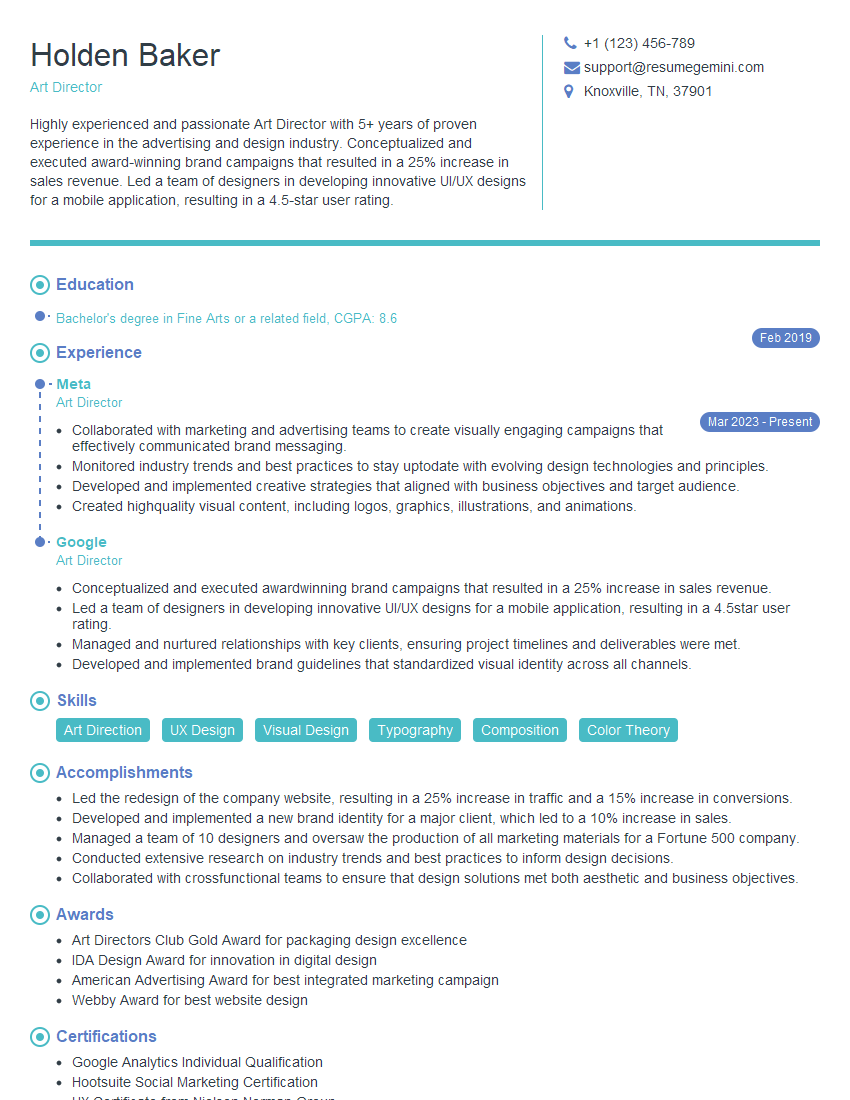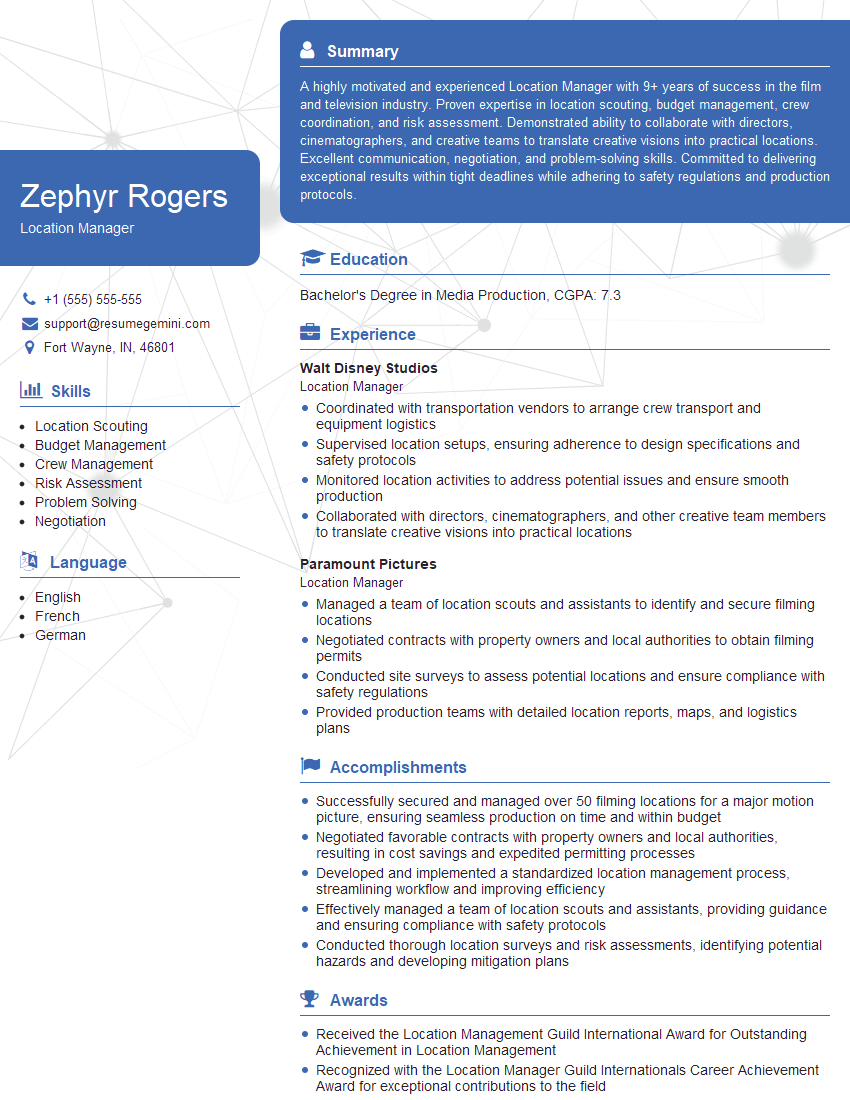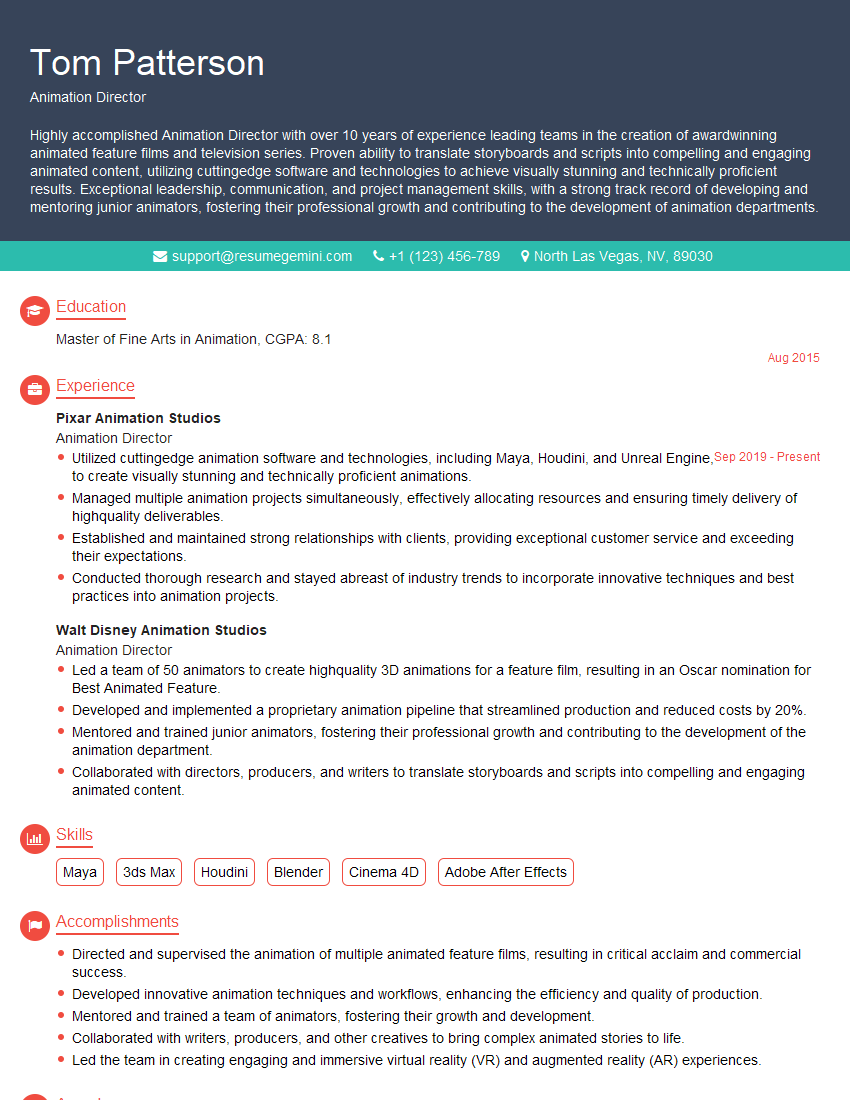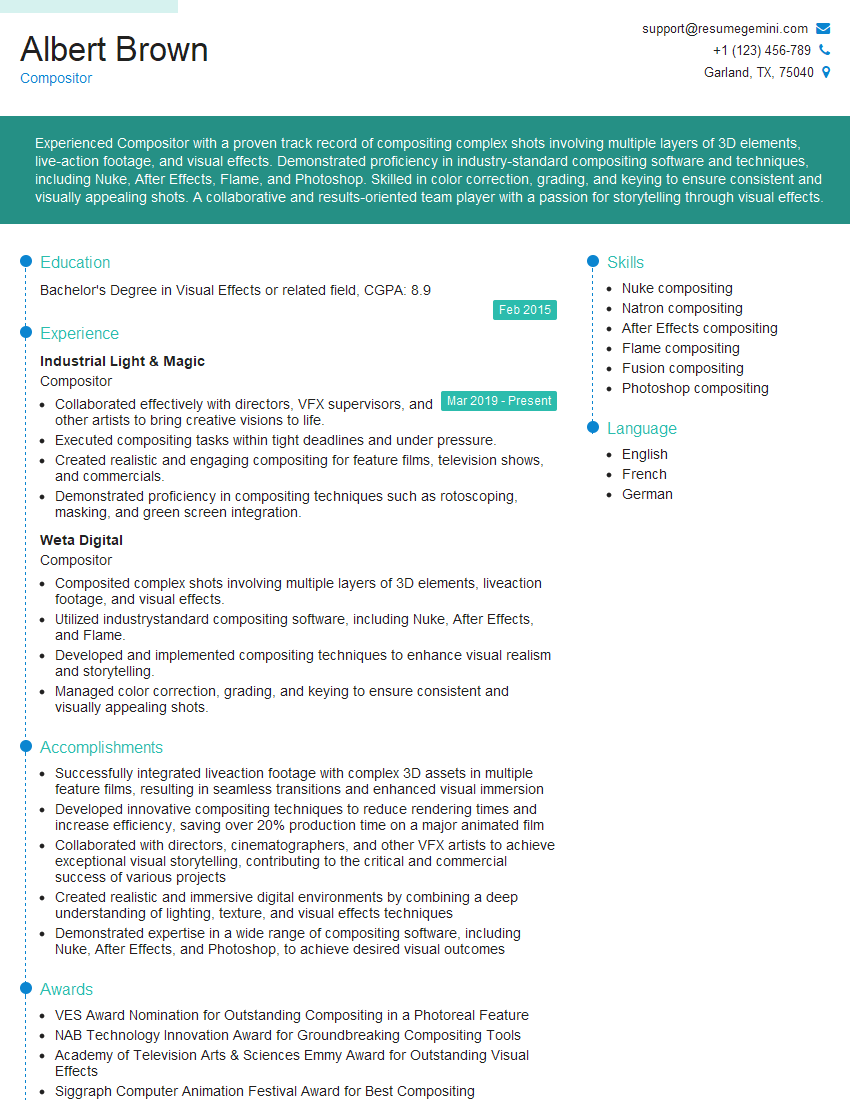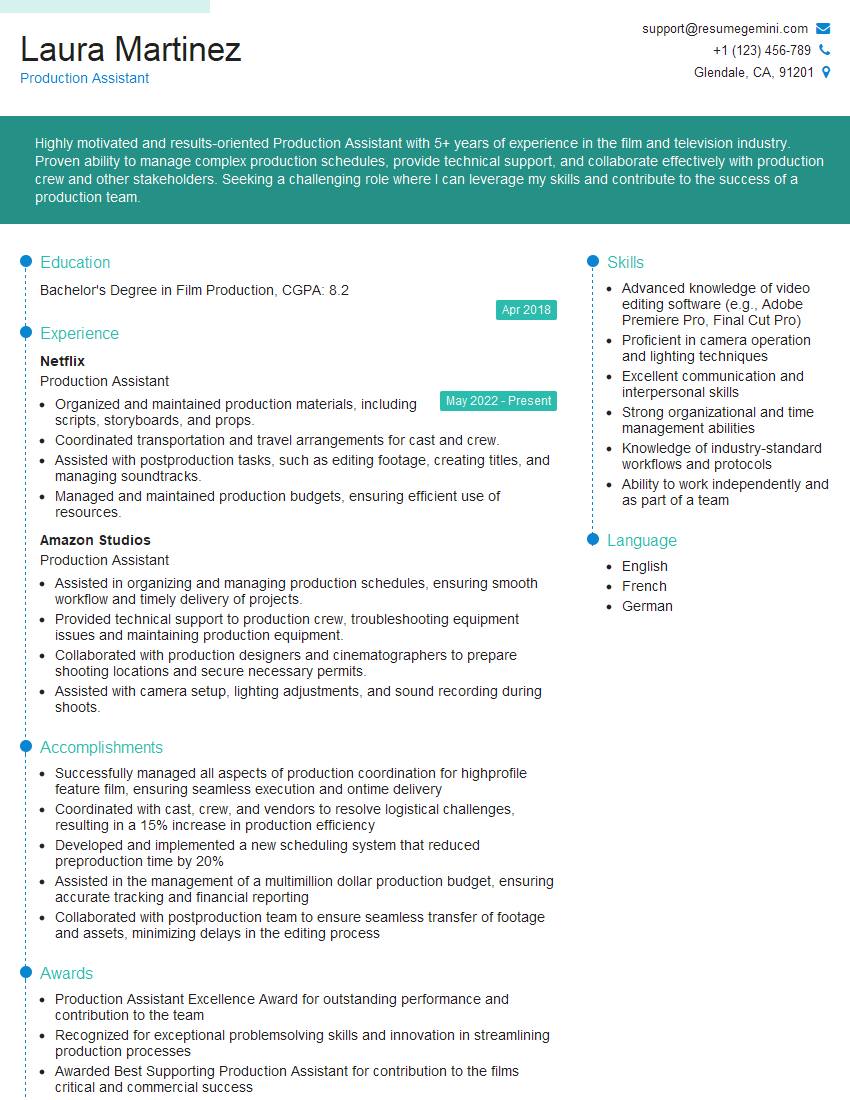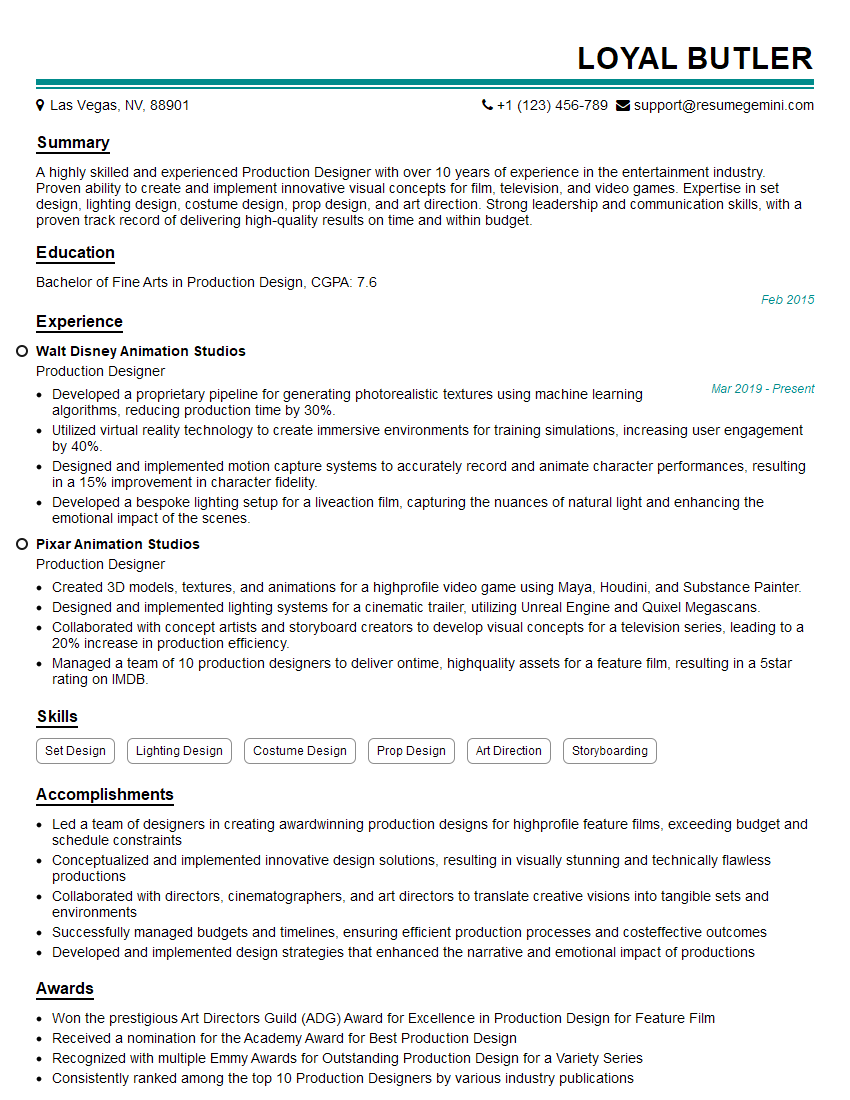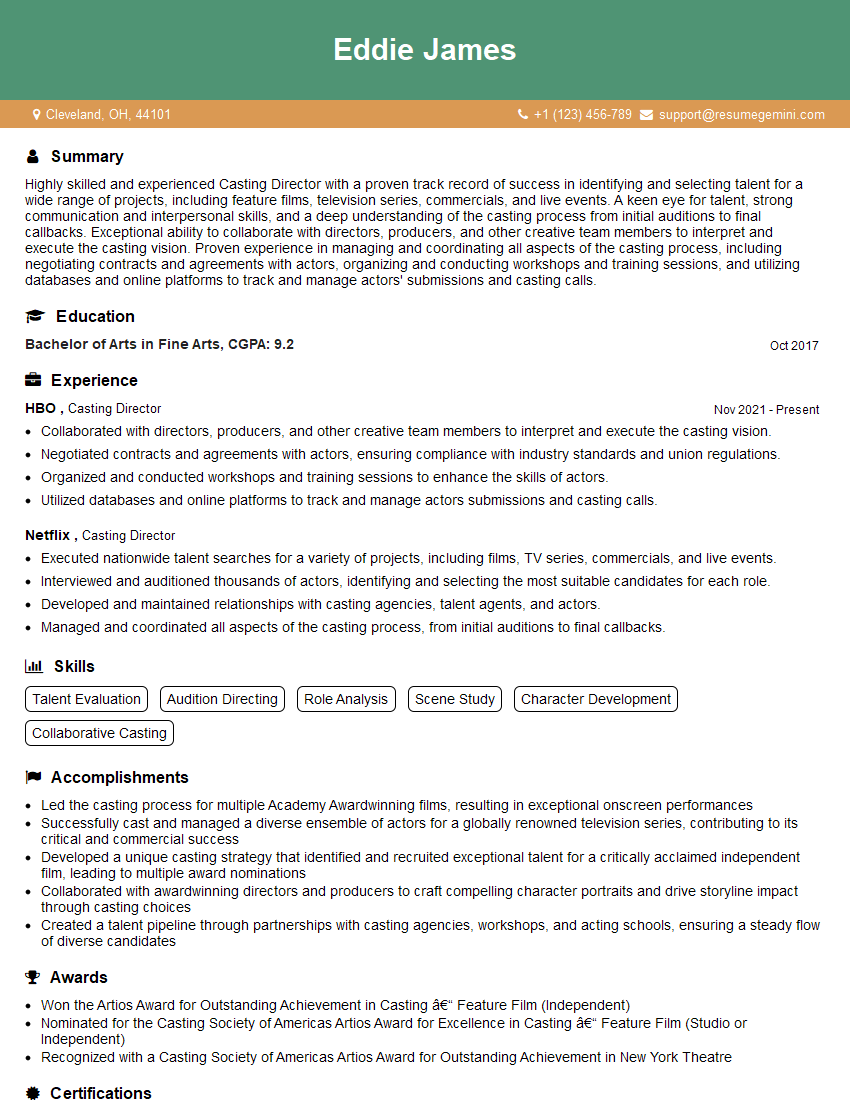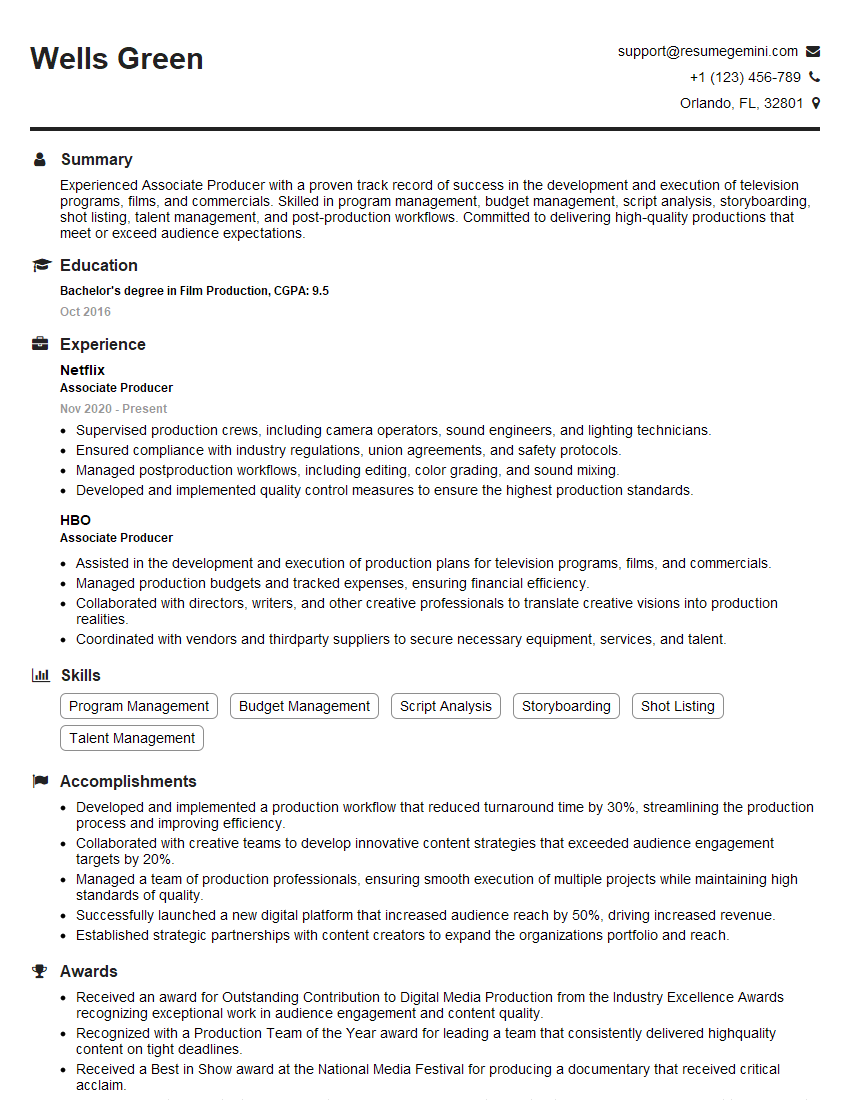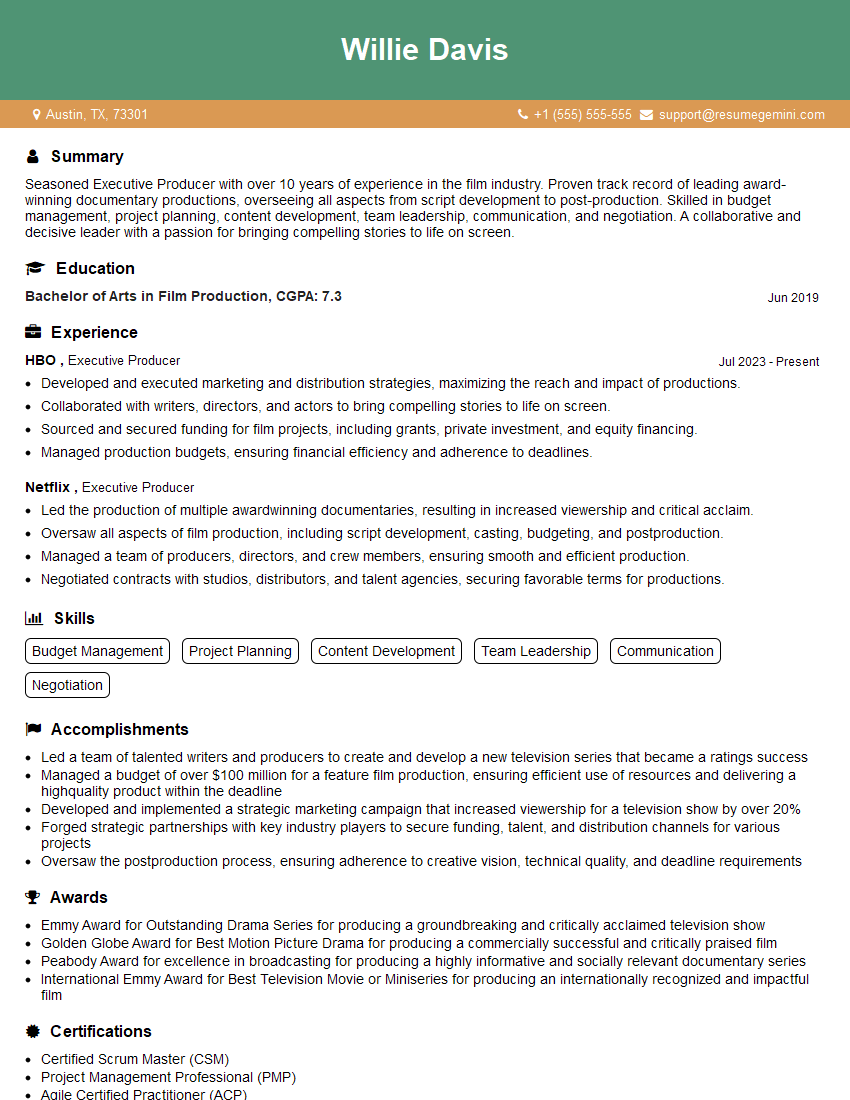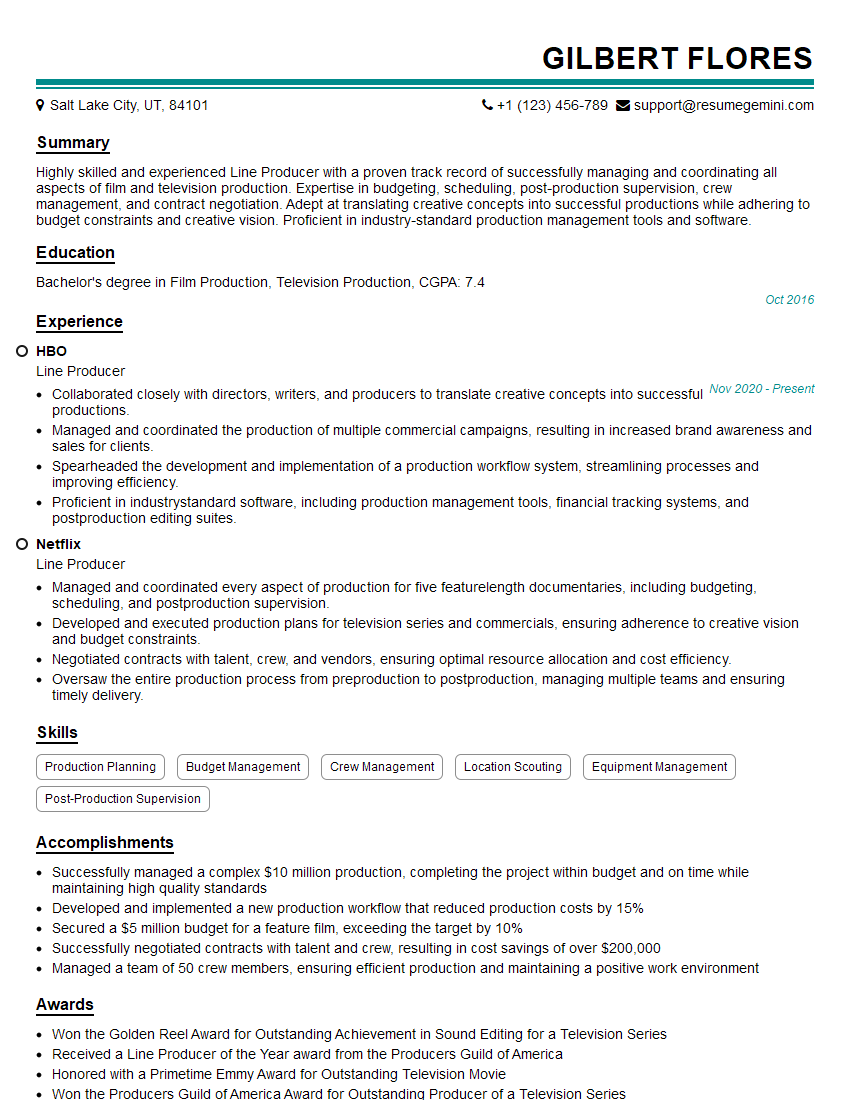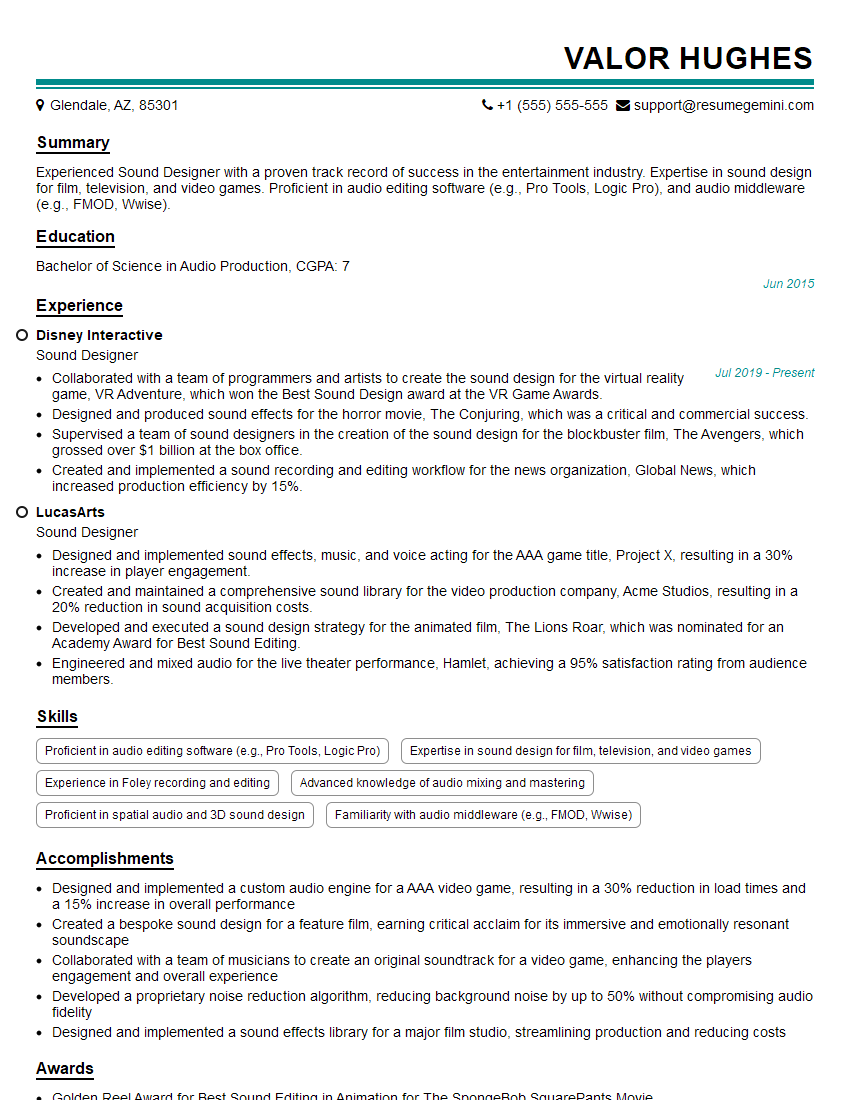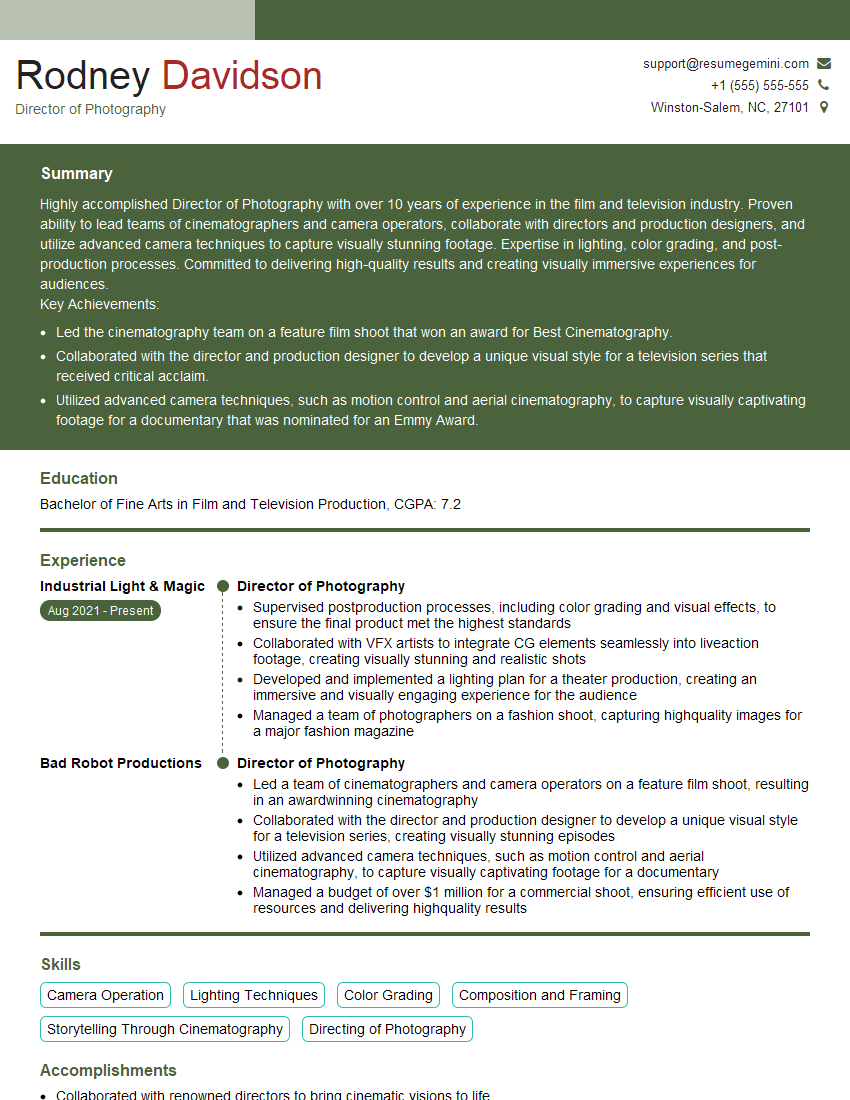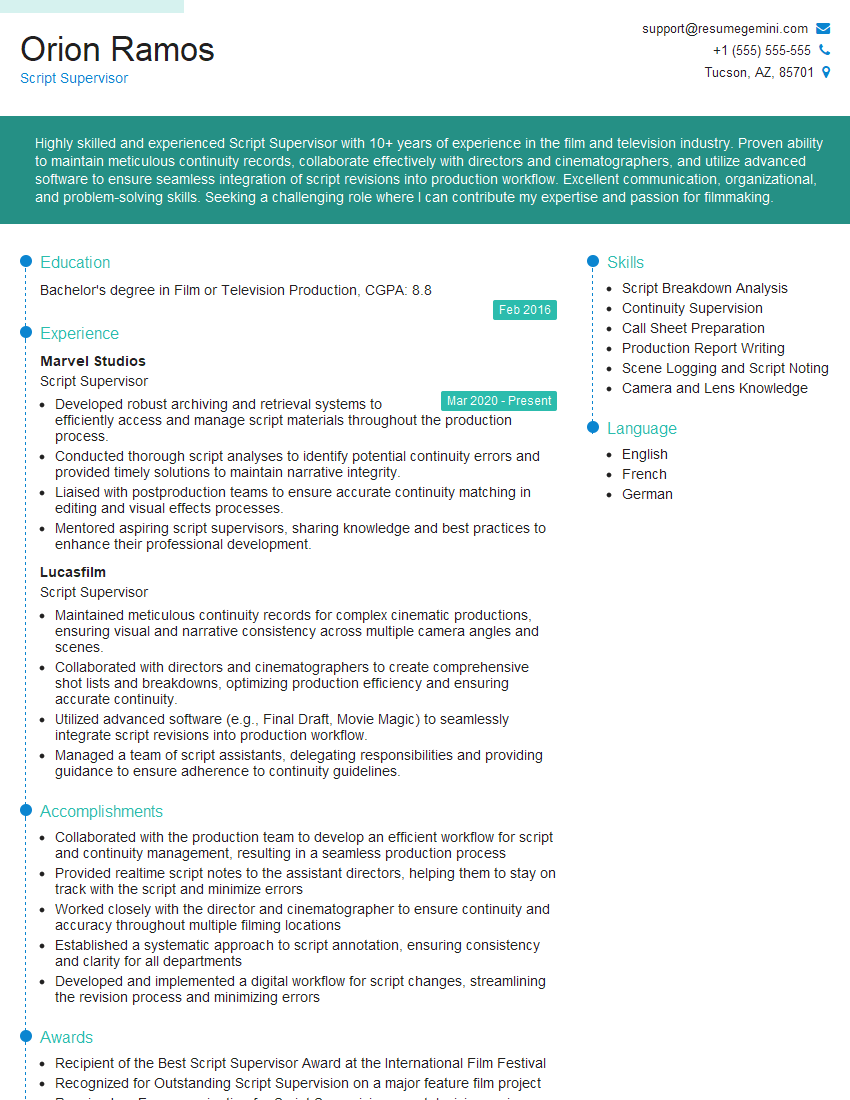Every successful interview starts with knowing what to expect. In this blog, we’ll take you through the top Collaboration with Directors and Producers interview questions, breaking them down with expert tips to help you deliver impactful answers. Step into your next interview fully prepared and ready to succeed.
Questions Asked in Collaboration with Directors and Producers Interview
Q 1. Describe your experience managing communication between directors and producers on a previous project.
Managing communication between directors and producers requires a proactive and organized approach. Think of it like orchestrating a symphony – each instrument (director, producer, department heads) needs to play their part harmoniously. On a recent documentary project, I established a central communication hub using a project management software. This allowed for real-time updates on schedules, budget, and creative decisions. Weekly status meetings were held, with clear agendas and assigned action items to ensure everyone was informed and accountable. I also facilitated one-on-one check-ins to address individual concerns and foster open communication. This multi-faceted approach ensured transparency and minimized misunderstandings. Regularly circulating detailed production reports further solidified the shared understanding of the project’s progress.
Q 2. How do you handle conflicting creative visions between a director and a producer?
Conflicting creative visions between directors and producers are inevitable, but manageable. It’s crucial to view these differences not as obstacles, but as opportunities for creative evolution. My approach is based on collaborative problem-solving. I first facilitate open dialogue, encouraging each party to clearly articulate their vision and rationale. I then act as a neutral mediator, identifying areas of common ground and potential compromises. Sometimes, data can be a powerful tool – audience research, test screenings, or even competitor analysis can provide objective insights to inform decision-making. The goal is to find a creative solution that satisfies both the artistic integrity of the director and the production realities understood by the producer. If a complete consensus can’t be reached, a clear decision-making process must be established, respecting the authority and responsibilities of each role.
Q 3. Explain your process for ensuring all stakeholders are informed and aligned on project goals.
Ensuring stakeholder alignment starts with clearly defined project goals documented in a comprehensive project brief. This document serves as the north star, guiding all decisions. Regular communication, in the form of updates and meetings, keeps everyone informed. Utilizing visual aids like Gantt charts or project timelines helps visualize progress and potential roadblocks. I also encourage open feedback and questions throughout the process. I always make sure to tailor communication to the audience’s needs; directors are typically more interested in creative updates, producers in budget and schedule adherence, while investors focus on the project’s overall performance and financial projections. By personalizing and customizing the information, we keep everyone engaged and motivated to work towards the same objective.
Q 4. How do you facilitate efficient decision-making in a collaborative environment with directors and producers?
Facilitating efficient decision-making involves establishing clear processes and roles. Before any significant decision, I ensure all stakeholders have the necessary information. This often involves preparing comprehensive briefing documents outlining the options, potential risks, and benefits of each. Structured meetings with pre-set agendas are essential. I often use techniques like nominal group technique or brainstorming to encourage participation and generate diverse ideas. By employing a clear voting mechanism (weighted voting or consensus building) we can make decisions fairly and promptly. After reaching a decision, I always ensure clear documentation of that decision and the reasoning behind it for future reference.
Q 5. Describe a time you had to negotiate competing priorities between artistic vision and budgetary constraints.
On a recent feature film, the director envisioned a complex, large-scale action sequence that significantly exceeded the allocated budget. My approach involved a phased negotiation process. First, I worked with the director to explore creative alternatives that would achieve the same dramatic impact but at a lower cost. This involved brainstorming, storyboarding, and exploring different filming techniques. Then, I presented the director with a range of options, each with a detailed breakdown of costs and benefits. We discussed the trade-offs between artistic vision and financial feasibility. Ultimately, we agreed on a revised version of the sequence that retained the core dramatic elements while staying within budget. This required open communication, compromise from both the director and the producer and strong collaboration between the entire team. The result was a compelling sequence that fulfilled the artistic aims while maintaining fiscal responsibility. Transparency throughout the process was vital to building trust and securing buy-in from all parties.
Q 6. How would you approach a situation where a director’s vision exceeds the allocated budget?
When a director’s vision exceeds the budget, I begin by understanding the reasons behind the cost overrun. Is it due to ambitious special effects? Extensive location shooting? A large cast? Once the cost drivers are identified, the next step is collaborative problem-solving. We explore options such as scaling back the scope of the project, securing additional funding, or finding creative solutions (e.g., using less expensive locations, adjusting the shooting schedule). This process often involves a careful analysis of the return on investment for each element of the vision. Sometimes, the most valuable asset is finding a compromise that maintains the heart of the director’s vision while adhering to budget constraints. Clearly documenting all options, their costs, and potential impact on the final product is critical for informing the decision-making process and securing buy-in from all stakeholders.
Q 7. What strategies do you use to build and maintain strong working relationships with directors and producers?
Building strong relationships with directors and producers relies on mutual respect, trust, and open communication. It’s about understanding each person’s working style, preferences, and communication methods. Active listening, empathy, and a willingness to understand their perspectives are critical. Regular one-on-one meetings beyond formal project updates foster personal connection. I strive to be proactive, anticipating potential challenges and offering solutions before they escalate into major conflicts. Celebrating successes together and acknowledging contributions build team morale and foster a positive work environment. Ultimately, building trust is a cornerstone of creating a collaborative and positive environment to produce high-quality results. My goal isn’t just to manage the project but to build enduring professional relationships.
Q 8. Explain your understanding of the different roles and responsibilities of directors and producers.
The director and producer, while both crucial to a film or show’s success, have distinct roles. Think of it like this: the director is the artistic captain of the ship, responsible for the creative vision and on-set execution, while the producer is the ship’s manager, ensuring everything runs smoothly and on budget.
- Director: The director’s primary responsibility is the artistic interpretation and execution of the script. They oversee all creative aspects, including casting, directing actors, working with the cinematographer on visual style, and ensuring the overall creative vision is realised. They’re responsible for the final product’s creative integrity.
- Producer: The producer manages all aspects of the production process, from pre-production planning and securing funding to overseeing post-production and distribution. They handle logistics, budgeting, scheduling, and legal matters, ensuring the project stays within budget and on schedule. They’re responsible for the project’s logistical and financial success.
In short: the director focuses on what gets made, while the producer focuses on how it gets made.
Q 9. How do you ensure the timely completion of tasks and milestones while maintaining collaboration?
Timely completion and collaboration are intertwined. I utilize a project management approach that combines proactive planning with constant communication. This starts with meticulously defined milestones and deliverables, laid out in a clear production schedule (often using project management software like Asana or Monday.com).
Regular check-ins – daily stand-ups at the beginning of the day, weekly progress meetings, and ad-hoc meetings as needed – are critical. These meetings aren’t just progress reports; they’re collaborative problem-solving sessions. Any roadblocks are identified immediately and addressed collaboratively, perhaps by reallocating resources or adjusting schedules. Open communication is fostered through a variety of channels, including email, instant messaging, and project management software, ensuring everyone stays informed and connected.
Transparency is key. Everyone on the team has visibility into the project’s progress and any potential challenges. This empowers them to contribute to solutions and fosters a sense of shared responsibility.
Q 10. Describe your experience managing creative differences between various team members.
Creative differences are inevitable in collaborative projects. My approach involves active listening, respectful dialogue, and finding common ground. I start by ensuring everyone feels heard and understood. I encourage each party to articulate their vision and rationale clearly, focusing on the underlying goals rather than getting bogged down in specific details.
Once all perspectives are understood, I facilitate a brainstorming session to explore alternative solutions that incorporate elements from each viewpoint. This process often involves compromises, but the goal is to arrive at a solution that satisfies the project’s overall creative goals while honoring the contributions of each team member. Sometimes, a compromise may involve splitting the creative decision (for instance, using one approach for part of the project and a different approach for another part).
Ultimately, my aim is not to force consensus, but to guide the team toward a collaborative solution that reflects the collective talent and vision.
Q 11. How do you handle pressure and maintain positive collaboration under tight deadlines?
Tight deadlines and pressure are inherent in film and television production. My strategy involves proactive planning, clear communication, and a strong team. Proactive planning includes building buffer time into the schedule to account for unforeseen delays. This avoids last-minute rushes and mitigates stress.
Maintaining open and honest communication is essential. I keep the team informed of any challenges or changes in the schedule. This transparency builds trust and helps the team prepare for potential obstacles. I also prioritize team morale by fostering a supportive and collaborative environment, encouraging breaks, and celebrating successes along the way. A supportive atmosphere helps the team to better handle pressure.
Finally, I lead by example, demonstrating a calm and composed demeanor, even under stress. This helps to keep the team focused and productive, even when things get challenging.
Q 12. What methods do you employ to track progress, manage expectations and maintain open communication?
Tracking progress, managing expectations, and maintaining open communication are interconnected and require a multifaceted approach. I use a combination of methods to ensure everything is on track.
- Project Management Software: Tools like Asana or Monday.com allow for centralized task assignment, progress tracking, and communication.
- Regular Meetings: Daily stand-ups for quick updates and weekly progress meetings for more in-depth discussions.
- Progress Reports: Regular written reports summarizing progress against milestones, identifying potential issues, and highlighting successes.
- Transparent Communication: Utilizing various communication channels (email, instant messaging, project management software) to keep the team informed and engaged.
- Expectation Management: Clearly defining roles, responsibilities, and deadlines at the outset, and keeping everyone updated on progress and any necessary adjustments.
By combining these methods, I maintain transparency and ensure everyone is aligned, reducing misunderstandings and fostering a collaborative environment.
Q 13. How do you resolve disagreements regarding scheduling, resources or creative decisions?
Disagreements are inevitable, but they can be constructively addressed. My approach is based on collaborative problem-solving.
- Identify the Core Issue: Clearly define the source of the disagreement. Is it a scheduling conflict, resource limitations, or a fundamental creative difference?
- Gather Information: Understand the perspectives of all parties involved. Encourage them to articulate their concerns and rationale.
- Explore Solutions: Brainstorm alternative solutions that address the concerns of each party while maintaining the overall project goals.
- Negotiate and Compromise: Guide the team toward a mutually agreeable solution. This often involves compromise and finding a balance between competing priorities.
- Document the Agreement: Once a decision is reached, clearly document it to avoid future misunderstandings.
The focus is always on finding a solution that works for the project as a whole while respecting the contributions of individual team members.
Q 14. Describe a time you had to mediate a conflict between a director and another department head.
In a previous project, a disagreement arose between the director and the head of the art department regarding the set design for a key scene. The director envisioned a minimalist, modern look, while the art director preferred a more ornate, classical style. This disagreement threatened to delay production.
I initiated a meeting with both parties, encouraging them to clearly articulate their artistic vision and the rationale behind their choices. We discussed the scene’s overall purpose and its importance to the story’s narrative. After understanding their respective perspectives, we brainstormed alternative designs that incorporated elements of both styles. We found a compromise using a more modern approach with subtle nods to classical elements. This addressed the director’s preference for a clean, modern aesthetic while satisfying the art director’s desire for a richer visual experience. The result was a set design that served both the story and artistic integrity.
Q 15. How do you ensure that all production stakeholders are aligned on the overall vision and strategy?
Aligning all stakeholders on a shared vision requires proactive communication and a clearly defined strategy. I begin by facilitating a series of collaborative workshops and meetings early in pre-production. These sessions involve directors, producers, key crew members, and even representatives from distribution or financing if relevant. The goal is to establish a common understanding of the project’s artistic goals, target audience, and budgetary constraints.
- Vision Document: We create a comprehensive vision document, outlining the narrative, aesthetic style, and overall tone. This serves as a central reference point throughout production.
- Regular Check-ins: Consistent communication is vital. Regular production meetings, often utilizing visual aids like storyboards or mood boards, ensure everyone remains informed and can voice concerns.
- Conflict Resolution: Disagreements are inevitable. I actively mediate and facilitate constructive discussions to resolve conflicts, finding solutions that respect both artistic integrity and business realities. For example, on a recent project where the director wanted a complex special effect that was outside the budget, we collaboratively explored alternative, more cost-effective options while maintaining the intended visual impact.
Career Expert Tips:
- Ace those interviews! Prepare effectively by reviewing the Top 50 Most Common Interview Questions on ResumeGemini.
- Navigate your job search with confidence! Explore a wide range of Career Tips on ResumeGemini. Learn about common challenges and recommendations to overcome them.
- Craft the perfect resume! Master the Art of Resume Writing with ResumeGemini’s guide. Showcase your unique qualifications and achievements effectively.
- Don’t miss out on holiday savings! Build your dream resume with ResumeGemini’s ATS optimized templates.
Q 16. How do you balance the needs of the creative team with the business objectives of the production?
Balancing creative needs with business objectives is a constant tightrope walk. My approach is to create a space where both are valued and integrated, not treated as opposing forces. This requires strong communication, negotiation, and a deep understanding of both artistic vision and financial realities.
- Prioritization: We collectively prioritize scenes and effects based on their impact on the narrative and the budget. Sometimes, creative compromises are necessary, and I guide the team towards finding innovative solutions within constraints.
- Data-Driven Decisions: When possible, I use data to support creative choices. For example, market research on similar films can inform decisions about casting, marketing, and even specific scene choices.
- Contingency Planning: Unexpected challenges arise. I always have contingency plans to address potential budget overruns or scheduling conflicts without sacrificing the core creative vision. For instance, I might suggest filming certain scenes at different locations to reduce costs or adjust the shooting schedule to accommodate actor availability.
Q 17. What is your approach to providing constructive feedback to directors and producers?
Providing constructive feedback requires sensitivity, specificity, and a focus on solutions. I avoid subjective criticisms and instead concentrate on objective observations and actionable suggestions. I frame feedback positively, emphasizing the strengths of the work while highlighting areas for improvement.
- Specific Examples: Instead of saying “the scene is slow,” I’d say, “The pacing in this scene feels sluggish between 1:15 and 1:30. Perhaps tightening the dialogue or adding a visual element could improve the rhythm.”
- Collaborative Approach: I present feedback in a way that invites discussion and collaboration. I encourage directors and producers to share their perspectives and find solutions together. This fosters a sense of partnership and shared ownership.
- Focus on Solutions: Along with identifying areas for improvement, I actively brainstorm and suggest solutions. My goal is to empower the creative team to overcome challenges and enhance their work.
Q 18. How do you contribute to creating a collaborative and supportive work environment?
Creating a supportive and collaborative environment is paramount. I foster a culture of trust, mutual respect, and open communication. This involves building strong relationships with team members, actively listening to their concerns, and recognizing their contributions.
- Team Building Activities: I organize team-building activities to facilitate bonding and strengthen relationships between crew members. This can range from informal social gatherings to more structured workshops focused on problem-solving.
- Open Door Policy: I maintain an open-door policy, encouraging team members to approach me with concerns or ideas at any time.
- Recognition and Appreciation: I actively recognize and appreciate individual and team accomplishments, publicly acknowledging contributions and celebrating successes.
Q 19. Explain how you use technology to facilitate communication and collaboration within a production team.
Technology plays a crucial role in facilitating communication and collaboration. I leverage various tools to streamline workflows, enhance communication, and improve the overall efficiency of the production process.
- Project Management Software: Tools like Asana, Monday.com, or Wrike are invaluable for task assignment, progress tracking, and file sharing. These platforms provide a central hub for all production-related information.
- Video Conferencing: Platforms like Zoom, Google Meet, or Skype enable seamless communication across geographical distances, facilitating real-time collaboration on creative decisions and problem-solving.
- Cloud Storage: Cloud-based storage services like Dropbox, Google Drive, or Box ensure secure and accessible file sharing among the team. This eliminates the need for physical file transfers and reduces the risk of data loss.
- Communication Platforms: Using Slack or similar platforms allows for quick communication, file sharing, and the establishment of dedicated channels for different aspects of the production, like VFX, post-production or scheduling.
Q 20. How do you effectively delegate tasks and responsibilities to members of the production team?
Effective delegation requires understanding team members’ skills and strengths. I begin by clearly defining tasks, setting realistic deadlines, and providing the necessary resources. I also ensure that each team member understands their responsibilities and has the autonomy to make decisions within their designated area.
- Clear Communication: I communicate expectations clearly, ensuring everyone understands the goals, deliverables, and timelines for each task.
- Empowerment: I empower team members by giving them ownership of their work and encouraging them to take initiative.
- Regular Check-ins: I conduct regular check-ins with each team member to monitor progress, address any challenges, and provide support as needed.
- Feedback and Recognition: I provide regular feedback on performance and recognize individual achievements to motivate and encourage continued high-quality work.
Q 21. What’s your experience with different collaboration tools used in film production?
My experience encompasses a wide range of collaboration tools used in film production. I’m proficient in using project management software (Asana, Monday.com, Wrike), video conferencing platforms (Zoom, Google Meet), cloud storage solutions (Dropbox, Google Drive), and communication tools (Slack).
Beyond these standard tools, I’ve also utilized specialized software for script collaboration (like Final Draft), visual collaboration platforms for storyboarding and pre-visualization, and review and approval tools for dailies and VFX shots. The selection of tools depends heavily on the specific project needs and the size of the production team. On smaller projects, simpler tools suffice, whereas larger productions benefit from more integrated and robust solutions.
Q 22. How do you manage competing deadlines and priorities to ensure efficient workflow?
Managing competing deadlines and priorities requires a proactive and organized approach. Think of it like conducting an orchestra – each instrument (task) has its own part, and they all need to come together harmoniously. My process involves several key steps:
- Prioritization: I use a combination of methods like the Eisenhower Matrix (urgent/important) and MoSCoW method (must have/should have/could have/won’t have) to rank tasks based on their impact and urgency. This ensures that the most crucial tasks are tackled first.
- Detailed Scheduling: I create a comprehensive project schedule, often using Gantt charts or project management software, that visually represents all tasks, deadlines, and dependencies. This allows for easy identification of potential conflicts and proactive adjustment.
- Regular Check-ins: Frequent meetings with the director, producer, and key team members are crucial. These check-ins allow for open communication, identification of roadblocks, and timely adjustments to the schedule based on emerging needs. Daily stand-ups can be highly effective.
- Resource Allocation: I carefully assess resource availability (people, budget, equipment) and allocate them efficiently to tasks. Over-allocation is a common pitfall that I strive to avoid.
- Contingency Planning: Unexpected delays are inevitable. I build buffer time into the schedule and have backup plans in place to mitigate the impact of unforeseen circumstances. For example, having a secondary location lined up for a shoot in case of weather issues.
For example, on a recent documentary, we had a tight deadline for archival footage acquisition. By prioritizing this task, dedicating a specific team member, and setting realistic timelines, we avoided delays that could have impacted the entire post-production schedule.
Q 23. Explain your process for documenting decisions and agreements within a collaborative production.
Documenting decisions and agreements is paramount for a smooth production. Think of it as creating a roadmap that everyone can follow. My process emphasizes clarity, accessibility, and accountability:
- Meeting Minutes: Detailed minutes are taken for all key meetings, including decisions made, action items assigned, and agreed-upon deadlines. These minutes are distributed to all attendees and stored in a centralized, easily accessible location (e.g., shared drive or project management software).
- Decision Logs: A separate log tracks significant decisions, including the date, decision-makers, rationale, and any relevant supporting documentation. This serves as a single source of truth.
- Email Confirmation: Important decisions and agreements are often confirmed via email, creating a written record that can be easily referenced later. This helps to minimize misunderstandings and disputes.
- Version Control: For creative assets (scripts, storyboards, etc.), version control is essential. This ensures that everyone is working with the most up-to-date versions and allows for tracking changes over time. Tools like Google Docs or specialized software are invaluable here.
- Contracts and Agreements: Formal contracts outline the responsibilities, deliverables, and payment terms for all parties involved, creating a legally binding framework for the project.
For instance, if a change in location is agreed upon, this would be documented in meeting minutes, the decision log, and perhaps a revised budget that reflects any additional costs. This transparency prevents future disputes.
Q 24. How do you ensure clear communication of changes and updates across the production team?
Clear communication of changes and updates is crucial for team cohesion and project success. It’s like keeping everyone on the same page in a boat during a storm. My strategy involves a multi-pronged approach:
- Centralized Communication Hub: We utilize a project management tool (e.g., Asana, Trello, Monday.com) that serves as a central hub for all updates, announcements, and files. This ensures everyone has access to the same information.
- Regular Team Meetings: Frequent, structured meetings keep everyone informed and allow for Q&A sessions. These can range from daily stand-ups to weekly progress reviews, depending on project needs.
- Email Updates: Important updates are disseminated via email to ensure wider reach, and provide a written record for future reference.
- Visual Communication: Using visuals such as Gantt charts, timelines, or even short video updates can make complex information easier to digest.
- One-on-One Check-ins: Individual check-ins with team members provide personalized feedback and address any concerns they might have. This fosters open communication.
For example, if a scene is cut from the script, the change will be reflected in the project management tool, communicated via email, and potentially discussed at the next team meeting. This layered approach minimizes confusion.
Q 25. Describe your approach to managing risk and anticipating potential challenges in a collaborative project.
Managing risk and anticipating challenges is proactive risk management, not reactive firefighting. This involves a structured approach focused on identification, assessment, and mitigation.
- Risk Identification: We brainstorm potential challenges early on, considering factors such as budget limitations, scheduling conflicts, creative differences, logistical hurdles, and potential legal issues. This often involves a SWOT analysis.
- Risk Assessment: We assess the likelihood and potential impact of each identified risk, prioritizing those that pose the greatest threat to the project’s success.
- Risk Mitigation: We develop strategies to mitigate identified risks. This might involve contingency plans (e.g., backup locations, alternative casting options), securing additional funding, or establishing clear communication protocols to address potential creative disagreements.
- Monitoring and Review: We continuously monitor the project for emerging risks and review the effectiveness of our mitigation strategies. This is an iterative process.
For example, on a large-scale production, we identified the risk of location permits being delayed. Our mitigation strategy included applying for permits well in advance, securing alternative locations as backups, and building buffer time into the shooting schedule.
Q 26. How do you ensure the ethical considerations are addressed throughout the collaborative process?
Ethical considerations are woven into every stage of a collaborative project. This isn’t an afterthought, but a core value. My approach involves:
- Clear Ethical Guidelines: From the outset, we establish clear ethical guidelines that address issues such as intellectual property rights, fair compensation, respectful workplace conduct, data privacy, and responsible representation of diverse groups.
- Informed Consent: When working with individuals, obtaining informed consent is crucial. This means ensuring everyone fully understands the project’s nature and their participation’s implications.
- Transparency and Accountability: We maintain transparency in all aspects of the production, ensuring that ethical concerns are openly discussed and addressed. This promotes accountability and fosters trust.
- Compliance with Regulations: We adhere to all relevant legal and regulatory requirements, including copyright laws, labor laws, and industry standards.
- Ethical Review Boards: For projects dealing with sensitive topics or vulnerable populations, engaging with ethical review boards can provide expert guidance and ensure ethical practices.
For instance, when depicting sensitive cultural issues, I ensure that we are consulting with relevant cultural experts and working closely with those communities to prevent misrepresentation or harm.
Q 27. How do you measure the success of a collaborative project involving directors and producers?
Measuring the success of a collaborative project is multi-faceted. It goes beyond simply completing the project on time and within budget. I consider several key metrics:
- Creative Achievement: Did the final product meet its artistic goals? Did it resonate with its target audience? This is assessed through critical reviews, audience feedback, and box office/viewership data (depending on the project).
- Financial Success: Did the project achieve its financial goals? This involves comparing actual costs to the budget and analyzing revenue generated.
- Team Satisfaction: Did the project create a positive and collaborative work environment? This is measured through team surveys and feedback sessions.
- Time and Budget Adherence: Was the project delivered on time and within budget? This reflects efficiency and project management effectiveness.
- Impact and Legacy: What is the lasting impact of the project? Did it achieve its intended social, cultural, or educational objectives?
For example, a successful documentary might not only earn critical acclaim but also raise awareness of a crucial social issue and inspire positive change. This holistic approach accounts for artistic merit, commercial viability, and societal impact.
Q 28. How do you adapt your communication and collaboration style to suit the personalities and preferences of different directors and producers?
Adapting my communication and collaboration style is key to effective teamwork. Every director and producer is an individual. It’s important to understand each person’s communication style and preferences.
- Active Listening: I start by actively listening to understand their communication preferences and working styles. Do they prefer email, in-person meetings, or instant messaging? Are they detail-oriented or big-picture thinkers?
- Observation: Observing their behavior and interactions in meetings provides valuable insight into their communication style.
- Tailored Communication: I then adjust my communication style accordingly. For example, I might provide more detailed reports to a detail-oriented producer, while focusing on key results with a big-picture thinker.
- Respect for Differences: I value and respect different communication styles. Creating a safe and inclusive space where everyone feels comfortable sharing their opinions is essential.
- Building Rapport: Building strong relationships and trust with each director and producer is fundamental to effective collaboration. This takes time and effort.
For instance, one director might thrive on brainstorming sessions and appreciate creative input, while another might prefer a more structured and detail-oriented approach. Adapting my approach accordingly fosters a stronger collaborative relationship.
Key Topics to Learn for Collaboration with Directors and Producers Interview
- Understanding Creative Vision: Learn to effectively interpret and contribute to the director’s and producer’s artistic vision, aligning your work with their overall goals.
- Effective Communication: Practice clear, concise, and proactive communication strategies for conveying ideas, addressing concerns, and providing updates throughout the production process.
- Problem-Solving & Adaptability: Develop skills in identifying and resolving conflicts or challenges that may arise during collaborative projects, showcasing your ability to adapt to changing circumstances.
- Workflow & Time Management: Demonstrate a thorough understanding of production workflows, deadlines, and the importance of efficient time management in a collaborative environment.
- Creative Feedback & Collaboration: Master the art of giving and receiving constructive criticism, fostering a collaborative environment where ideas are shared and refined respectfully.
- Resource Management & Budgeting (if applicable): Understand the principles of resource allocation and budget management within the context of film or media production, depending on the specific role.
- Conflict Resolution & Negotiation: Develop strategies for navigating disagreements professionally and finding mutually agreeable solutions, prioritizing the project’s success.
- Understanding Different Roles & Responsibilities: Familiarize yourself with the roles and responsibilities of directors and producers and how your role complements theirs.
Next Steps
Mastering collaboration with directors and producers is crucial for career advancement in the creative industries. It demonstrates essential soft skills highly valued by employers and opens doors to more challenging and rewarding opportunities. To maximize your job prospects, it’s vital to create an ATS-friendly resume that effectively highlights your relevant experience and skills. ResumeGemini is a trusted resource to help you build a professional and impactful resume tailored to your specific career goals. Examples of resumes tailored to showcasing collaboration with directors and producers are available to guide your resume creation process. Invest time in crafting a compelling resume—it’s your first impression on potential employers.
Explore more articles
Users Rating of Our Blogs
Share Your Experience
We value your feedback! Please rate our content and share your thoughts (optional).
What Readers Say About Our Blog
Hi, I represent an SEO company that specialises in getting you AI citations and higher rankings on Google. I’d like to offer you a 100% free SEO audit for your website. Would you be interested?
good

